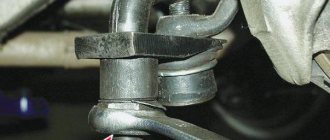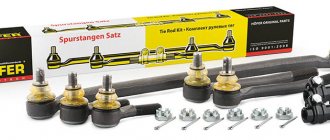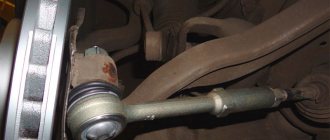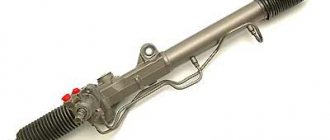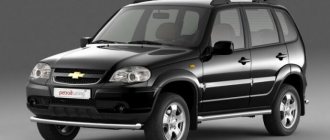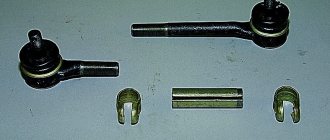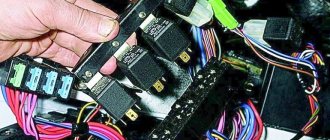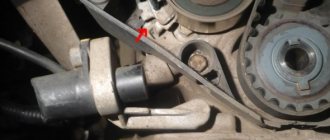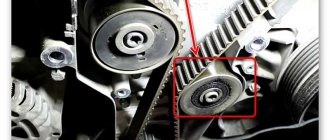Steering rods play an important role in driving a car. Chevrolet Niva is no exception. Thanks to these rods, the steering knuckle is connected to the steering mechanism, which ensures the rotation of the wheels.
This part is made of steel and at the ends has a steering tip and a threaded connection, thanks to which the short and long tips are connected, it is also called a hinge. They allow moving parts in the steering structure to move freely.
Replacing steering rods Niva Chevrolet
Bent steering rods must be replaced without fail, since editing this important steering element is unacceptable due to the fact that cracks may appear in the material of the rod.
Removing the side rod
We hang and remove the wheel.
To remove the right side rod, turn the steering wheel all the way to the left.
Use pliers to remove the cotter pin
Using a 22mm wrench, unscrew the nut securing the side link to the steering knuckle lever.
Use a puller to press the ball pin out of the lever.
A fork puller can be used.
If there is no puller, unscrew the nut not completely, insert the mounting blade into the spacer between the side rod and the steering knuckle lever and hit the end of the lever with a hammer.
The ball pin can also be pressed out of the lever by striking a sharp blow from below with the back of a hammer on the steering knuckle lever near the hinge
We remove the ball pin from the eye of the steering knuckle lever.
Use a puller to press the ball pin out of the pendulum arm.
The finger can also be pressed out by striking a sharp blow from below with a hammer through a chisel with a blunt end on the pendulum lever.
We take out the right side rod.
Similarly, remove the left side rod.
We install the side link so that a long tip is attached to the steering knuckle lever.
Removing the middle link
We carry out the work on an inspection ditch or a lift.
Use pliers to remove the cotter pin
Using a 22mm wrench, unscrew the nut securing the middle link to the pendulum arm.
Using a fork puller, press the middle link ball pin out of the hole in the pendulum arm.
The pin can also be pressed out by applying a sharp blow from below (near the hinge) with a chisel with a blunt end to the pendulum arm.
Remove the ball pin from the eye of the pendulum arm.
Similarly, we press the ball pin out of the bipod.
Remove the middle link.
Install the middle link in the reverse order.
The left hinge pin (inserted into the bipod hole), in addition to rotation, can swing (unlike the right one).
In this case, when installing the rod on the car, we orient it so that its longitudinal axis is in front of the hinge axes
Replacing mud caps and tie rod ends
Mud caps and tie rod ends can be replaced on the vehicle.
For clarity, these operations are performed with the traction removed.
To replace the dirt cap, knock it out with a soft metal drift.
We clean the ball joint from old grease and dirt.
If traces of corrosion are found on the ball pin and free movement of the pin in the body is felt, replace the ball joint with the rod end.
We press the new dirt cap onto the hinge body with a suitable piece of pipe, resting on the metal ring of the cap.
Before replacing the rod end, measure the distance between the hinge axes.
Using a 13mm wrench, unscrew the nut of the adjusting clutch clamp bolt, holding the bolt with a wrench of the same size.
Use a slotted screwdriver to loosen the clamp.
Hold the adjusting coupling with a pipe wrench and unscrew the tip (we use a pipe placed on the ball pin as a lever).
Inner (short) and outer ends with ball joints, clamps and adjusting sleeve.
We assemble the rod in the reverse order.
We adjust the tips so that the rod is the same length (see photo 3).
After adjustment, tighten the clamps on the coupling. After replacing the tips, we check the wheel alignment
Main components of the steering mechanism.
The steering linkage consists of several main elements interconnected:
The column itself consists of two parts - an intermediate shaft, which is connected to a trapezoid using a hinge, and a steering column on which the wheel is attached. To ensure the best connection of the steering wheel, it has conical splines.
The side rods are composite; for adjustment, there is a split coupling in the middle. There is a left-hand thread on one end of the tip, and a right-hand thread on the other. As the clutch rotates, the length of the lever can either increase or decrease. This is necessary to be able to adjust the toe angle of the wheels.
Standard clamps are used to secure the coupling. The rods end with hinges. They usually have a cone-shaped fit and nuts are used to secure them.
The hydraulic booster is a system consisting of several additional elements:
The column is attached to the left side member using three bolts. The power steering pump is located on the left side of the engine. To rotate it, an additional belt is used to connect the auxiliary units.
Steering rods on Niva Chevrolet
Steering rods play an important role in driving a car. Chevrolet Niva is no exception. Thanks to these rods, the steering knuckle is connected to the steering mechanism, which ensures the rotation of the wheels.
This part is made of steel and at the ends has a steering tip and a threaded connection, thanks to which the short and long tips are connected, it is also called a hinge. They allow moving parts in the steering structure to move freely.
Installation
As in the case of ball joints, before installation we recommend that you look under the boot and see what’s going on with the lubricant. All manufacturers shout that the plant contains the required amount of lubricant in the product for the entire service life. There are several comments about this. Namely: what the factory calls lubricant, the amount of lubricant and operating conditions (and this may be the most important thing). Our factories, with tenacity worthy of better use, work with “lithol-like” lubricants. When it comes to the “south,” no one will pay attention to it. But people in the northern regions know that after parking for the night, they need to drive several turns so that the steering becomes easier and more precise. This is nothing more than frozen grease in the steering ends and ball joints. For such things we use lubricant from the manufacturer Elf-Total - S2A (our price list includes it). This is a semi-synthetic lubricant with very good water-repellent properties, and most importantly a wide temperature range. But don't go overboard with the quantity. A small layer is enough to cover the part of the ball protruding from the body. Now directly to the installation. Even in St. Petersburg there are very few service stations left where you can immediately go to a wheel alignment stand. As a rule, this is a separate workshop. The advice is this: talk to the master “before”. Two St. Petersburg masters where I usually send people advised the following. Let people come with a steering linkage and steering end bushings, we will supply everything ourselves. And it will be cheaper for the client and we don’t have to bother with dirty threads. The price list contains two items. Chevrolet Niva steering linkage separately, and together with steering wheel bushings. The price in the second case is less than these parts separately. Citizens of the “nivavoda”, this article is also relevant for you, only the trapezoid for the field is DIFFERENT, the thrust geometry is different. Manufacturer, lubrication and installation - one in one.
Malfunctions
Since the entire steering mechanism is a rather shaky structure, it constantly requires diagnosis and must be carefully monitored, and all necessary repair measures must be taken as soon as possible if the following symptoms occur:
- There was a backlash. This may indicate that the hinges are very worn. In this case, you can try to replace only the hinges or completely change the entire mechanism.
- The steering wheel turns hard and you can hear a squeaking sound around the wheels
Very often the protective cover is damaged, and dirt and moisture begin to get there, so you need to do a technical inspection as often as possible.
Replacement
To replace, we will need new steering rods for the Chevrolet Niva and a set of tools; after everything is ready, we can proceed to replacement:
- Installing the car in the pit
- We remove the wheel from the side where the replacement will be made.
- Remove the pin pin from the outer hinge
- We take a special puller and remove the hinge pin from the steering knuckle. If there is no puller, you can use a hammer to apply small blows to the end of the lever
- Remove the cotter pin from the inner hinge nut, then unscrew the nut
- We press out the ball joint pin, this can be done using the same puller or a hammer
- Removing the steering rod
- Install the new part in reverse order
Replacing the middle link
- We press out the pin of the side rods and move the entire structure to the side
- Unscrew the four nuts and disconnect the gearbox stabilizer
- We remove the cotter pin of the ball joint and the fastening nut and unscrew the fasteners
- Pressing out the tip
- Removing the rods
- Replace with new ones
Problem
The Chevrolet Niva steering linkage lives quite a long time. If the car was operated on good surfaces, then more than 100 thousand kilometers. Even on bad roads, I have never seen a case where the steering rods were killed in less than 50 thousand kilometers. We won’t take extreme sports and “rides” into account. The problem turned out to be in the Russian style - you need to buy a high-quality new part. At the disassembly site, where I order donors for the cylinder head, the balls and trapezoids are swept away immediately. I asked, out of naivety, who needs tie rods with play. Disassemblers said that they were being taken for restoration. The anthers on the tips are replaced, the rods are washed, and most importantly, by hitting the back of the tip with a hammer, the backlash is removed. We get a “new trapezoid” for the price of 6 anthers. All this has been going on for a month. And no more is needed, the “10 days for a check” period has passed. The second option is just a Chinese counterfeit in white and blue boxes, for the TAZ car. But this is already so banal that I don’t even want to talk about it. The sad thing is that the trapezoid itself is not that expensive, but after installation the alignment has already been done, and this money “flies down the drain.”
Reinforced
The standard set of steering rods for the Niva Chevrolet is not strong enough, since the car is usually used mainly off-road. Therefore, a reinforced version was developed that has the following advantages:
- Long service life
- There is a protective threaded connection thanks to which the toe can be adjusted over a long period of time
- Serial tips, this indicates the quality of manufactured parts
- You can lubricate yourself without removing the protective cover
The main disadvantage is the high price of the product, which reaches 3,500 thousand. Even before installing them, they need to be additionally lubricated.
To summarize, we can conclude that it is necessary to periodically diagnose your car, this will allow you to identify the malfunction in a timely manner, thereby helping to avoid serious breakdowns. If it is possible, replace the standard rods with reinforced ones, this will help you forget about the problems with this element for several seasons.
Ready-made kits of parts, enhanced modifications and recommended manufacturers
In case of replacing steering control elements in stores, you can choose kits not only from factory production, but also from various other companies.
The standard set includes:
As an alternative to original spare parts for Shnivy, you can consider purchasing from the following manufacturers:
Useful! To solve the problem of frequent wear of the moving joints in the steering, reinforced “ AMG ” steering rods are produced. This is the best choice for any task! Mercedes Daimler AG and Lemforder tie rod ends with the possibility of their additional lubrication during operation (grease fittings).
The advantages of reinforced products include:
Reference! The disadvantages include the relatively high cost of the kit - 2500-3500 rubles, while the original standard set will cost 1500 rubles.
Therefore, to maintain the good condition of the moving vehicle controls, it is necessary to regularly:
Steering rods on Chevrolet Niva: purpose, design, replacement
In the control chain of cars, including the Chevrolet Niva, steering rods play an important role. This device is designed to connect the steering mechanism and the steering knuckle. This connection allows the wheels of the car to turn and is part of the steering drive.
Steering is an important link through which the vehicle turns. And if any part of the steering mechanism fails, this is fraught with unpredictable consequences. To avoid breakdowns of such products on the Niva Chevrolet crossover, it is necessary to periodically carry out inspections and monitor the condition of the parts. In this article, we will look at the main purposes of steering rods, their design features, and how worn parts are replaced on a Chevrolet Niva SUV (video).
Purpose of steering rod on Chevrolet Niva
A tie rod is a steering part that transmits force from the steering wheel to the steering knuckles, which ultimately causes the wheels to rotate. The rod is a steel tube, at the ends of which there is a threaded connection and a steering tip. The threaded design ensures the connection between the short and long tips. The tips are also called hinges. They are designed to allow free movement of moving parts in the steering structure.
Faulty steering rods of the Niva Chevrolet
The steering mechanism is a rather capricious design that requires diagnosis every year, especially for a car like the Chevrolet Niva. After all, as you know, Shniva is designed to overcome particularly harsh road and off-road surfaces.
The first sign of a faulty steering mechanism is increased play. This may indicate a malfunction of the steering rods due to extreme wear of the hinges. In this case, there are two ways to correct the situation:
- Carry out restoration of steering rods, replacing worn mechanisms (hinges).
- Replace the entire mechanism.
Diagram and description of the design
In the steering design, the tie rod ensures the transmission of force from turning the steering wheel to the steering knuckles of the wheels. This part is made in the form of a steel rod; movable ball pins with threads are installed at the ends.
The kit includes left, right and middle adjustable rods and tie rod ends of various lengths. Steering rods provide control of the car on the road and the ability to turn the wheels in the desired direction.
But as you know, the more moving parts there are in a mechanism, the greater the likelihood of wear and failure of one or more parts.
Dismantling and replacement of Kedr steering rods and reinforced steering rods on a Chevrolet Niva (VAZ 2123)
There was a strong vibration in the steering wheel. Has stopped. What could it be? Or it could be a lot of things - the drive, the hub, the tie rods, or the wheel just came off. I checked - everything is tight. I pulled the drive and it didn't wobble. I tapped the wheels with my feet and drove on. The vibration became stronger and turned into a strong beating. We turned around and let's go. 60 km - no beat, 70 - 80-90 - no beat, no vibration - everything is normal! I took off the front wheels and inspected everything again.
Found it! There was play in the outer right steering tip, but it was not felt by hand, but only with the help of a mounting tool. But why did the beating first appear and then disappear - that is the question? So I drove for another week without any beats or vibrations. Well, it needs to be repaired, you can’t drive for so long at your own peril and risk. For a long time I was looking for assembled right and left rods, but in stores (or rather, only in Pasker) there were only VIS rods, and they were on display without one boot. As a result, I bought the entire KEDR trapeze.
I drove the car into the garage and began to disassemble the old rods. To simplify this task, I bought this puller
puller for vaz 2101
But he simply did not fit the fist and the pendulum lever. I had to go to the store again for another puller
Remove the cotter pins and unscrew the nuts - left wheel
Now we take a puller and begin to press out the tips on one side
Internal uncomfortable tip
On the other side-
About the puller - it also turned out to be damp, I had to modify it a little with a grinder - to widen and deepen the recess for the ball pin of the rod, I think this puller is also not very successful.
Assembling Cedar steering rods on a Chevrolet Niva
The old rods have been dismantled, I’m assembling new ones from KEDRA - right
and the left rod, but on the left rod KEDR placed a SURPRISE - the length of the long outer tips is the same, and is equal to the length of the right short tip (our right outer tip is 6-7mm shorter than the left one!). Well, what should you do, if you assemble the left rod with a short tip, then you get a large gap between the tips, and this will affect the strength of the assembly. I ran to the spare parts, bought Trekov long tips there...
length difference between tips
and assembled a CEDAR-TRACK left tie rod!
Here it is, the joint brainchild of KEDROTRACK. Manufacturers of all VAZ spare parts and assemblies - UNDERSTAND!
In order not to do a wheel alignment, I measured the length of the new assembled rods with a caliper using the old dismantled ones. For my own peace of mind, I added some lubricant under the anthers, otherwise there wasn’t enough there.
There was simply no ShRB...
... and here they are just recommended for ball ones.
One of the necessary tools in Shnivy!
fill it with lubricant
We remove the rings from the anthers, insert a flat screwdriver between the anther and the finger, and turn them 90 degrees.
and insert a syringe into the resulting space and add lubricant
Well, in fact, I stuck all the assembled rods into their seats.
It’s still better to check the wheel alignment, I didn’t do it only because there was still some work to be done on the suspension, and the car wasn’t pulling to the sides.
Reinforced steering rods for Chevrolet Niva (VAZ 2123)
Reinforced steering rods Niva, LADA 4×4, Chevrolet Niva
Reinforced steering rods Niva,
LADA 4 x 4, Chevrolet Niva
. Reinforcement due to the use of a closed and, accordingly, more rigid threaded connection. Calibrated alloy steel hexagon, 24 mm wrench. The closed threaded connection is protected from corrosion and reduces the possibility of backlash in the rod adjustment unit. The use of this design eliminates damage to the steering rod (bending, weakening of the coupling) and guarantees the preservation of toe adjustments under the most severe operating conditions.
No disassembly required when adjusting toe
.
Make: Niva, LADA 4×4, Chevrolet Niva. Body: VAZ-2121, VAZ-21211, VAZ-21212, VAZ-2122, VAZ-21213, VAZ-21214, VAZ-21215-19, VAZ-2131, and their modifications.
The kit includes: 1. Steering rod coupling Niva, LADA 4×4, Chevrolet Niva - 2 pcs., material - steel, zinc coating. 2. Nut M16x1 - 2 pcs., material - steel, zinc coating. 3. Nut M16x1.5xL - 2 pcs., material - steel, zinc coating. 4. Tie rod end VAZ 2101-07,2121 short, 2101-3003134 - 2 pcs.
Steering rods on Chevrolet Niva: purpose, design, replacement
In the control chain of cars, including the Chevrolet Niva, steering rods play an important role. This device is designed to connect the steering mechanism and the steering knuckle. This connection allows the wheels of the car to turn and is part of the steering drive.
Steering is an important link through which the vehicle turns. And if any part of the steering mechanism fails, this is fraught with unpredictable consequences. To avoid breakdowns of such products on the Niva Chevrolet crossover, it is necessary to periodically carry out inspections and monitor the condition of the parts. In this article, we will look at the main purposes of steering rods, their design features, and how worn parts are replaced on a Chevrolet Niva SUV (video).
Purpose of steering rod on Chevrolet Niva
A tie rod is a steering part that transmits force from the steering wheel to the steering knuckles, which ultimately causes the wheels to rotate. The rod is a steel tube, at the ends of which there is a threaded connection and a steering tip. The threaded design ensures the connection between the short and long tips. The tips are also called hinges. They are designed to allow free movement of moving parts in the steering structure.
The steering mechanism is a rather capricious design that requires diagnosis every year, especially for a car like the Chevrolet Niva. After all, as you know, Shniva is designed to overcome particularly harsh road and off-road surfaces.
The first sign of a faulty steering mechanism is increased play. This may indicate a malfunction of the steering rods due to extreme wear of the hinges. In this case, there are two ways to correct the situation:
- Carry out restoration of steering rods, replacing worn mechanisms (hinges).
- Replace the entire mechanism.
Also an important indication of a faulty steering linkage is difficulty turning the steering wheel. This suggests that, most likely, low-quality parts were installed or the factory technology was violated during their manufacture. Incomplete lubrication of connections from the factory will soon lead to product malfunction; in this case, squeaks will be heard from under the wheels when the steering wheel is rotated.
Steering rod puller
Mechanical damage to the protective cover of the rods often occurs, which leads to water and dirt getting into the mechanism and compromising the integrity of the device. To protect yourself from waste and your car from malfunctions, it is necessary to periodically carry out a technical inspection of the vehicle.
Replacing the device
If the steering rod is damaged and fails, it should be replaced immediately. Replacement can be carried out either independently in the garage or at a service station.
To perform work on replacing the side rods, you will need a “22” key, pliers and a removable mechanism for pressing out the hinge. The work order is as follows:
- The Niva Chevrolet car is installed on an overpass or lift.
Another puller option
- The front wheel is removed, requiring replacement of the part.
- The cotter pin of the outer hinge pin is removed and its nut is unscrewed.
- A puller is installed and the hinge pin is removed from the swing arm. The video below shows how to properly press out a finger with a puller. For your information! There is no need to purchase a puller to remove the hinge pin. In this case, you can use a hammer, striking the end of the lever boss accordingly.
- The cotter pin is removed from the inner joint nut, after which the nut is unscrewed and removed.
- Using the same puller, you need to press out the ball joint pin (tip).
- The steering rod is removed and replaced with a new one.
- Installation of the rod is carried out in the reverse order of removal. The video shows the process of both removal and installation.
Advice! To avoid violation of the wheel alignment angles, it is necessary to measure the length between the center of the hinge of the old product before carrying out work. Set this distance on the new product by loosening the coupling bolts. If you forget to set the wheel rotation angle, you should contact a service station for maintenance.
Replacing the middle link on a Chevrolet Niva is carried out in the following sequence:
- The side rod pin is pressed out and its structure is moved to the side.
- Before removing the transverse link, it is necessary to disconnect the gearbox stabilizer. To do this, you need to unscrew the four mounting nuts. After this, the gearbox should rotate a short distance and open access, which will help extract the rod.
- The cotter pin of the fastening nut and the ball joint pin to the bipod are removed and the fasteners are unscrewed.
- Using a puller, the tip is pressed out. If you don't have a puller, you can use a hammer. The video shows the process of pressing out the finger.
- The steering rod is removed and replaced.
- The installation procedure is the reverse of removal, which can be seen in more detail in the video.
Reinforced steering rods for Chevy Niva
A basic set of steering rods, whatever one may say, is still ineffective, especially if the vehicle is used exclusively off-road. Factory reinforced tie rods are available to solve this problem. Many car enthusiasts try to solve this problem on their own by overcooking or overcooking the parts. But it’s best to purchase a reinforced set of steering rods and put them on your iron horse. The advantages of reinforced products include:
But there are some disadvantages of this material:
- Before installation, it is best to additionally lubricate the tie rod ends, since the manufacturer saves on everything.
- The high cost of the product, which ranges from 2500 to 3500 rubles, while a set of standard products costs up to 1000 rubles.
According to reviews from the Internet, such reinforced products do exist, especially for SUVs. Concluding the above, it is worth noting that periodic diagnostics of the vehicle will prevent not only breakdowns while driving, but will also reduce the need to replace worn parts. If you install reinforced rods, you can forget about problems with their breakdowns for at least two or three seasons. Good luck with the repair work, dear Shnivovody!
Replacing rods and steering linkage on a Chevrolet Niva
One of the important elements in a car is the steering, thanks to which the vehicle turns. Failure of any part included in this mechanism can lead to unpredictable consequences. Therefore, it is very important to monitor the condition of all parts. Particular attention should be paid to the steering rods, which connect the steering knuckle and the steering wheel; thanks to this design, the wheels turn.
How to replace the crosspiece on a Niva SUV yourself
The Niva car is equipped with two driveshafts that are part of the all-wheel drive system. They transmit energy to the front and rear axles and are a prefabricated structure with crosspieces as their central link. If the crosspiece fails, it must be replaced immediately. This will prevent damage to the driveshaft and failure of the car’s drive system.
Causes and signs of part malfunction: how to detect
The crosspiece is the key link of the driveshaft. Thanks to it, torque is transmitted from the gearbox, causing the shafts to rotate. Usually one of the crosspieces fails, of which there are four in Lada 21213. If it is not replaced in time, the steam room will quickly become unusable. The crosspieces allow the driveshaft to rotate evenly; if they break, play appears and the car loses power.
To avoid any unpleasant surprises on the road, you need to monitor the condition of the crosses. Carry out a thorough inspection of them regularly, clean and apply lubricant at least every 10 thousand km. If a part has become unusable, it must be replaced in a timely manner.
Parts in the drive system become unusable due to play in the units, which is caused by increased loads and mechanical stress. The wear of the crosspiece is facilitated by its unfavorable location. It is located close to the road surface, so it often gets sand, dirt, water and dust. Wear depends on the following factors:
- quality of parts manufacturing;
- driver's driving habits;
- sudden temperature fluctuations;
- the quality of roads, which leaves much to be desired;
- operating conditions;
- ingress of dust, sand, dirt, stones and water.
What is power steering and what does it consist of?
Thanks to this device, steering the wheels of a car becomes easier, while no great physical effort is required from you; those who have not dealt with cars without it do not really understand the importance of this device. The system of this element includes:
- Tank
- Pump
- Manual hydraulic rack
- Valve system
Let's look at these system details in more detail.
- The first element is a plastic tank; it contains the liquid that is used in the gur system; it can be either synthetic or mineral. Therefore, its content level should be checked.
- The power steering pump is the main element that performs the function of power steering, which is filled with an oil mixture; it runs from the car engine itself. It is activated by a temporary transmission. It consists of a chamber, blades and shaft, inlet and outlet. While the engine is running, liquid is pumped into it, forming a certain pressure; if there is an excess of it, the check valve will operate, which is responsible for how much of this liquid should be in the system.
- Rotary valve is responsible for auxiliary functions. It helps when turning the steering wheel, and when there is no such need, it is in a calm state, without affecting the wheel angle settings.
- The steering rack is a regular mechanical rack to which hydraulic lines are connected, which act as a driving force that is felt when the wheel alignment angle changes.
This is a device that allows you to control the wheels of a car using the steering wheel without much physical effort. Anyone who has never driven a car without power steering will find it very difficult to imagine the importance of this function. The amplifier is especially indispensable in heavyweight cars, which include the Chevrolet Niva.
An important function in a car is performed using such components as:
- Pump;
- Tank;
- Valve system;
- Manual hydraulic rack.
Purpose
The steering rods are located in such a way that the Chevrolet Niva steering linkage has three rods, one middle and two side. There is a tip at the ends of each; the connection occurs through threaded couplings, which are held in place by clamps. At the end of each there are ball joints, which are secured with several nuts. Thanks to this design, the wheels rotate. In order for the SUV to remain stable and feel great on the road, you need to check the gap at the ball joints as often as possible, and if it is large, you need to replace the tips. The condition can be checked by driving the car into an inspection hole, and if there is any play or gap, you can try to eliminate it by tightening all the clamps; if this does not help, then you need to make a complete replacement.
How to determine wear
To make sure that the tips need to be replaced, you should check their wear. One of the easiest ways is to check for play by hand. We turn the wheel out, press the upper part of the tip with the palm of our hand, and press it, while pressing the hinge from below with a finger. If there is any play, it means the tip is faulty and needs to be replaced.
Faulty steering ends will make themselves felt when the car drives over uneven surfaces. When driving through potholes or uneven surfaces, the steering wheel will feel squeaking. Also, when driving on a flat road, you should slightly turn the steering wheel left and right. If the tips are faulty, play will be felt.
If during a visual inspection you find a torn tip boot, you can safely replace it with a new one.
Replacement
To replace it, you need to prepare a screwdriver, a jack, and a pair of keys for thirteen and twenty-two.
To make the replacement correctly, you must strictly follow the entire sequence of work given below. We turn the steering wheel all the way; if we remove the right link, we turn the steering wheel all the way to the left. We jack up the body and remove the wheel, then do the following:
When setting your attention, you should pay attention to the long rod end, which is attached to the steering knuckle; it is from this that you can understand that there is a malfunction in the steering linkage. Therefore, in order to maintain the system in proper condition, it is necessary to regularly check it, and if there is a knocking or creaking sound in the steering area, this may indicate a malfunction in the system. As for the price and spare parts, it all depends on the manufacturer, the main thing is to purchase it in specialized stores or from trusted sellers, since they produce a lot of crafts for the Chevrolet Niva.
Replacing the middle link of Chevrolet Niva
Tools:
Parts and consumables:
Notes: Bent steering rods must be replaced, since editing this important steering element is unacceptable due to the fact that cracks may appear in the rod material. It is more convenient to do the work on a lift. You can also do it on a car mounted on supports. Replacing the middle link is shown using the example of disconnecting the ball joint from the bipod of the steering mechanism. Disconnect the rod from the pendulum arm in the same way.
1. Remove the corresponding wheel.
2. Press the side link ball joint pin out of the steering arm and move the side link to the side as described here.
3. Removal of the transverse link is hampered by the front axle gear housing (the pins of the linkage ball joints cannot be completely removed from the eyes of the bipod and the pendulum arm). Therefore, disconnect the front axle gearbox from the stabilizer by unscrewing the four nuts securing the stabilizer brackets to the gearbox housing. Under its own weight, the gearbox will rotate on the front supports, and a gap will open between it and the rod, sufficient to remove the rod.
4. Unscrew the nut securing the middle link ball joint pin to the steering gear bipod.
5. Unscrew the nut.
6. Install the puller and press the ball joint pin out of the steering gear bipod boss.
7. Remove the steering rod.
8. Install the new steering rod and other removed components in the reverse order of removal.
9. When installing the rod on the car, we orient it so that its longitudinal axis is in front of the hinge axes.
10. The left hinge pin (inserted into the bipod hole), in addition to rotation, can swing (unlike the right one).
11. We install the middle thrust in the reverse order.
Helpful Hint: If the steering boot is damaged, replace it as described here.
The article is missing:
Blow, more blow and bumps
The tip, and in particularly difficult cases, the steering rod can be destroyed by running over an obstacle. A stone on the road, a log or a hole - it doesn’t matter, there can be one outcome - a bent rod or a failed tip.
“As a standard, our specialists carry out routine diagnostics of the suspension at each subsequent maintenance. It also includes checking the tie rods and ends. It doesn’t matter how much the car had driven at the time of servicing - 15 or 150 thousand km; in rare cases, the rod ends can be “killed” even on a new car with low mileage.
Also interesting: ❶ How to increase the cross-country ability of the Niva
Do we repair everything at once or partially?
Possible problems with rear axle rods are not only fairly easy to diagnose, but relatively easy to fix.
A) Found a bent rod?! Happens!
We take and change it alone or together with a paired element. There is no need to change all five parts at once.
B) The silent block has served its purpose.
Dry or torn elastic can also be replaced separately. It’s inexpensive; you just have to first remove the rod, and then, after a series of manipulations, install it back.
B) A torn bracket or a broken rod.
This is already serious. If the rod can, again, simply be replaced, then the bracket will have to be welded, and then the welding points will have to be protected from corrosion.
